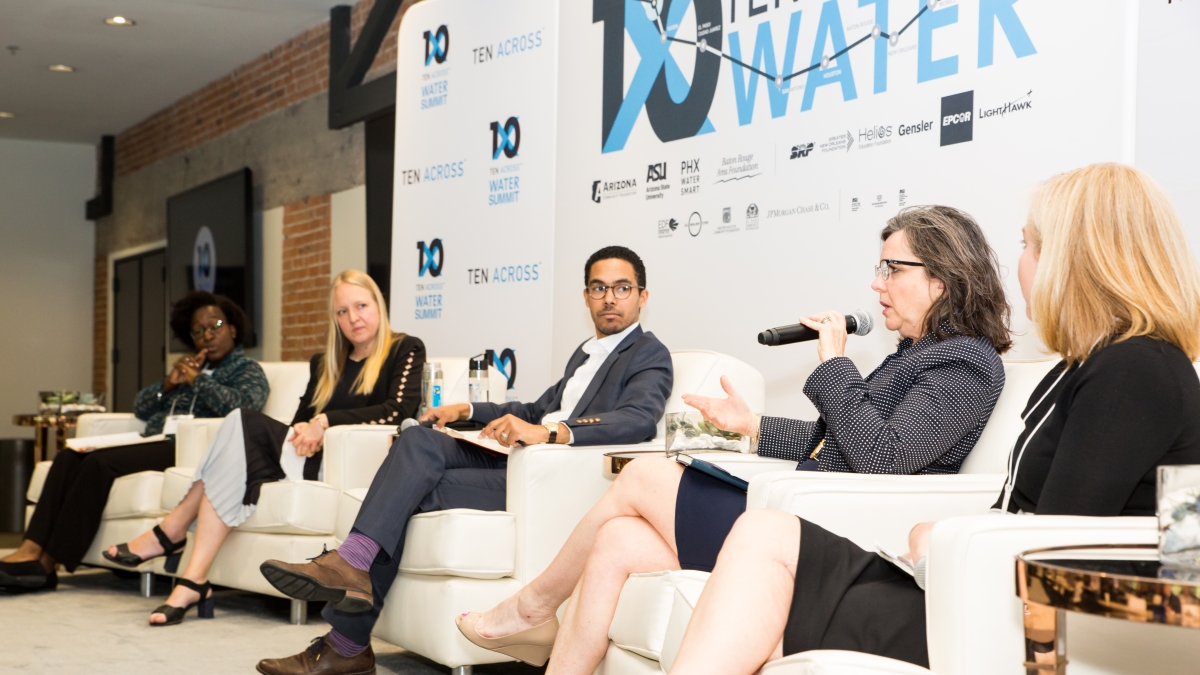Eleven cities, along a 2,400-mile stretch of the southern United States, united by Interstate 10 and water.
Too much of it, too little of it, and sometimes both.
The I-10 corridor faces other issues as well: globalization, land use, immigration, growth constraints, mobility, resilience and energy.
“It’s uncanny how this transect reveals the big issues of our time,” said Wellington "Duke" Reiter, founder of the Ten Across Initiative, which examines the region as a living laboratory for the future of the entire country.
The initiative’s second summit, hosted which began Tuesday evening and runs through Thursday in Phoenix, brought together urban planners, water experts, resilience officers, authors, academics and climate wonks for a discussion of issues facing the region.
About 250 people attended the summit, which was spearheaded by Arizona State University.
Arizona Gov. Doug Ducey opened the summit by noting the Phoenix metro area uses less water than it did in 1957 when Dwight Eisenhower was president. “This didn’t happen by accident,” Ducey said. “Along this I-10 corridor, we all have unique challenges with water. … I’m confident if we work together, there’s no challenge we can’t overcome.”
Phoenix is dealing with a prolonged drought, climate change and a lack of shade, said Mayor Kate Gallego.
“Collaboration will help us address these challenges,” she said.
The Valley of the Sun has faced floods, drought and growth throughout its life, said Mike Hummel, chief executive officer of Salt River Project, the water and power utility that has shepherded the area’s growth since territorial days.
“I don’t know how we’ll deal with (these issues) in the future, but I do know getting groups like this to talk is the way to make that happen,” he said.
“Nobody here is just a spectator,” Reiter added.
While Arizona is in the throes of a two-decade drought, Louisiana faces the opposite problem. The Gulf state loses a football field of land every 100 minutes.
Houston also faces issues of inundation. The fourth-largest city in the nation still has thousands uprooted by Hurricane Harvey two years ago.
“We are a city controlled by water,” said Margaret Wallace Brown, interim director of Houston’s planning and development department. “We have a huge challenge with too much water.”
On the other hand, there’s Phoenix. Water use in the desert city has fallen 30 percent in the past 20 years while serving 400,000 more residents.
“Scarce resources do not tend to limit growth,” said Kathryn Sorensen, Phoenix's director of water services, in a panel discussion on the limits of growth.
The city sits atop an aquifer of 9 million acre-feet. Annual water use is about 300,000 acre-feet.
“That is not a checking account,” Sorensen said. “It is a savings account.”
Sorensen credited Phoenix’ success in serving a growing population to Arizona’s sound water management with some of the most progressive aquifer management policies in the world, such as the requirement that developers produce evidence anything they build will have sufficient water for a century.
Transportation is Houston’s biggest limiter of growth, said Brown. Sprawl and more affordable housing on the city’s fringes are having an impact, she said.
In Southern California, 85 percent of that region’s water supply comes over the San Andreas fault.
“That’s a problem,” said Marissa Aho, outgoing chief resilience officer for Los Angeles and equivalent incoming to the city of Houston.
“Integrated planning comes out of necessity,” Sorensen said. “Hot and dry is going to get worse. You can’t live through a summer in Phoenix without understanding water is matter of life and death,” she said.
Follow 10 Across on Twitter for more quotes, photos and insights from the conference.
Top photo: (From left) Bridgett White, director of planning, city of San Antonio; Marissa Aho, chief resilience officer, city of Houston; Jeff Hebert, partner, HR&A Advisors Inc.; Margaret Wallace Brown, interim director of planning and development, city of Houston; and Kathryn Sorensen, director of water services, city of Phoenix, speak on a panel titled "The Limits to Growth Revisited" in Phoenix on Wednesday. Photo by Ashley Lowery
More Science and technology

4 ASU researchers named senior members of the National Academy of Inventors
The National Academy of Inventors recently named four Arizona State University researchers as senior members to the prestigious organization.Professor Qiang Chen and associate professors Matthew…

Transforming Arizona’s highways for a smoother drive
Imagine you’re driving down a smooth stretch of road. Your tires have firm traction. There are no potholes you need to swerve to avoid. Your suspension feels responsive. You’re relaxed and focused on…

The Sun Devil who revolutionized kitty litter
If you have a cat, there’s a good chance you’re benefiting from the work of an Arizona State University alumna. In honor of Women's History Month, we're sharing her story.A pioneering chemist…


